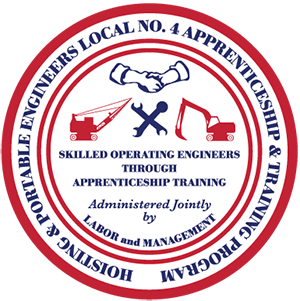Greetings Brothers and Sisters,
After what seemed to be a very quick summer and fall, the winter season is here once again. I hope you all enjoyed your Thanksgiving. I wish you all a safe and fun holiday season. Let’s hope that the New Year continues with the success and prosperity that Local 4 has been blessed with in recent years. With our incredible leadership and staff, I am sure it will be.
I would like to take this time to congratulate our newly hired Organizers, Tayla M. Rose and Ryan P. Mancini. They have both come up through the ranks and serve on our Executive Board. Their enthusiasm and talent will be a good addition to Business Manager Bowes’ phenomenal team.
On the safety front, my focus this quarter will be on the basic hitches and slings we use on a daily basis. Whether it be steel erection, demolition, or excavation, if there is an operating engineer there, you can bet there will be a sling used. It is important we understand their limitations and inspection criteria. We need to set an example on the jobsite. We can do that by being proactive with sling inspections.
Slings are assemblies that are used for lifting when connected to a lifting mechanism. All types of slings are required to have identification tags on them. They will state the diameter, length, and type of slings. They will also state the capacity of the sling. The capacity will be displayed for three of the most common hitches. A vertical hitch is a single sling attached with a shackle to a load. Care must be taken not to stretch the end connections. A choker hitch is formed when the sling is wrapped around the load and runs through itself up to the lifting point. It will be good for approximately 75% of the vertical capacity. It is a good choice when load control is important. It is also good when there is an uneven center of gravity. The strongest of the three common hitches is the basket. It is formed by wrapping the sling around the load and fastening both ends to the lifting point. A basket hitch is good for 200% of the vertical capacity. That is only true if the diameter of the load is 25 times the diameter of the sling or greater. (D/d ratio) Capacity is reduced anytime that ratio drops.
The most specific sling removal criteria focus on wire rope slings. Wire rope sling should be removed when there are ten randomly distributed broken wires in one rope lay. They should also be removed when there are five broken wires in one strand in one lay. Wearing or scraping of one-third of the original diameter also warrants removal. You must also inspect for kinking, crushing, and bird caging. Chain slings must be inspected for wear, deformation, and increase in length. Synthetic slings must be inspected for abnormal wear, melting or charring, punctures, and tears, broken or worn stitching, and distortion of fittings. Any abnormality warrants removal of service.
Once again, I wish you all a safe and prosperous New Year. If you have any questions on what I have covered, or anything on safety in general, please reach out. Have a good winter!
Fraternally yours,
Thomas McEvoy
Co-Safety Officer
